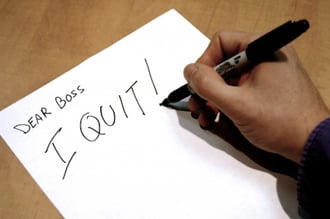 You know that high employee turnover isn’t something any company wants. It’s a pain to find a new hire and go through the motions of training and orientation over and over again. But there’s a lot more on the line than that. The cost of employee turnover is significant. It can affect your bottom line. Though some are hard costs that you can see in your bank account, many of the costs involved are hidden, so you don’t think about them as much. You might not realize how much you’re actually losing when an employee leaves and you have to find a replacement. You don’t have a realistic portrayal of the real cost.
You know that high employee turnover isn’t something any company wants. It’s a pain to find a new hire and go through the motions of training and orientation over and over again. But there’s a lot more on the line than that. The cost of employee turnover is significant. It can affect your bottom line. Though some are hard costs that you can see in your bank account, many of the costs involved are hidden, so you don’t think about them as much. You might not realize how much you’re actually losing when an employee leaves and you have to find a replacement. You don’t have a realistic portrayal of the real cost.
When you lose an employee, here’s what you’re really paying for.
Finding a New Hire
When you have to find a new hire, you have the costs for posting on job boards, the cost of recruiters, and the cost of interviewing. All of the time you’re spending on looking through resumes, talking to other managers for feedback, and spending hours in an interview room with different candidates is time you’re taking away from your other responsibilities. And this time equals money. You could be paying an outside recruiter to find you the ideal candidates, or you could be paying your in-house recruiting staff or HR professional to do the job—and this time costs, too.
Training and Orientation
If you have to pay for seminars, courses, and classes for a certain position, you can see what you’re paying in real dollars. But if the training you’re doing is in-house, the costs are less obvious. You have to pay someone to sit there and help the person get accustomed to your systems and procedures and someone has to double check the new hire’s work for a while to ensure he’s doing it right. That’s time away from the trainer’s regular job, which means you’re paying two people to do one job for a while. Not so cost effective.
Lost Productivity and Overworked Staff
Chances are you’re not going to find a replacement the same day your employee leaves. That means work is being left undone. This lowers your overall productivity. Or, you farm out the work to your existing staff, meaning that their own work starts to suffer and their satisfaction with their jobs start to go down, too. They might start thinking about looking for another job because they can’t take the stress. Even once you fill the vacancy, it can be hard to get them back on track and regain their goodwill.
Lost Knowledge
Unless you’re losing a low-level employee who hasn’t been on the job for very long, you’re going to lose knowledge when that person goes. You’re going to lose the skills the person has acquired while at your company as well as the relationships that person has built with suppliers, colleagues, others in the industry, and prospects.
Retention Is the Key to Savings
So what do all of these costs accumulate to? You’ll see a lot of estimates and averages. On the high end, it could end up being 150 percent of the employee’s annual salary. It may be a bit less for lower level positions. When you realize how much you’re actually losing with employee turnover, it should make you think about making retention a top priority at your company. Finding the right employees from the start and keeping them happy with proper compensation and a happy, healthy, and rewarding work environment is the key to retaining your workers and saving yourself from the cost of employee turnover.

